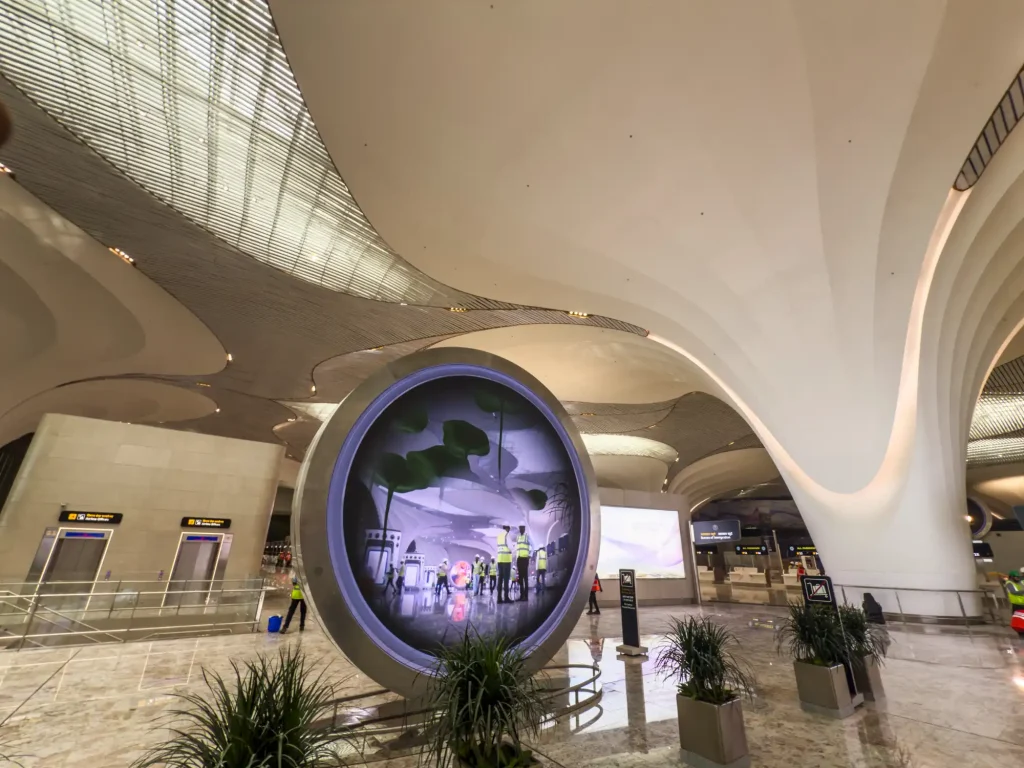Navi Mumbai International Airport showcases a blend of culture and modernity. Large digital screens throughout the terminal display flight information alongside Maharashtra and India’s artistic and cultural heritage. The airport, designed in the shape of a lotus, combines traditional architectural elements with state-of-the-art technology. Prime Minister Narendra Modi is scheduled to inaugurate the first phase on Wednesday, with commercial flights from Ulwe, roughly 37 km from South Mumbai, set to begin in December.
Passenger Convenience and Smart Features
Arun Bansal, CEO of Adani Airport Holdings, highlighted the airport’s focus on reducing passenger stress through technology. Key features include:
- 32,000 sq ft of digital art installations and 4,000 sq ft of LED screens
- Pre-booking for parking and fully Digi Yatra-enabled gates
- 66 conventional check-in counters and 22 self-baggage drop counters
- Mobile app for ordering food anywhere in the airport
- Food hall featuring restaurants under the “Bombay Bond” concept
- Gaming zones, kiosks, and paperless transactions

Passengers can pre-order meals from cloud kitchens with 10–15 minute service. Automated baggage handling, luggage belt notifications, and direct home-to-destination luggage delivery enhance convenience.
Capacity and Expansion
The airport will initially handle 20 million passengers per year (MPPA), scaling up to 90 MPPA in the final phase, making it India’s largest airport. The facility spans 1,160 hectares and is managed by Navi Mumbai International Airport Limited (NMIAL), a joint venture between Mumbai International Airport Ltd. (74%) and CIDCO (26%).
Future plans include four terminals linked by automated people movers, underground fuel systems, and advanced cargo and passenger movement networks. A connector from Coastal Road to Atal Setu will further improve access from Mumbai.
Cargo and Airline Operations
NMIA plans to handle 3.8 million metric tonnes of cargo annually and establish India’s largest MRO facility. Airlines including Akasa Air, IndiGo, and Air India are already onboard. Initial operations will accommodate 20–23 aircraft movements per hour, with room to expand as the airport stabilizes.
Investment and Development
Phase 1 saw an investment of Rs 20,000 crore, with Rs 30,000 crore allocated for Phase 2. About 65% of funding comes from debt. Terminal capacities are as follows:
- Terminal 1 (Phase I & II): 234,000 sqm, 20 MPPA
- Terminal 2 (Phase III): 400,000 sqm, 30 MPPA
- Terminals 3 & 4 (Phase IV & V): 20 MPPA each, cumulative 90 MPPA
Advanced Technology and Connectivity
NMIA incorporates cutting-edge systems:
- 5G-enabled operations for efficiency and productivity
- IoT-based real-time baggage and passenger monitoring
- Contact-free Digi Yatra processing and automated boarding
- Smart traffic management and secure Wi-Fi
- Automated baggage handling system and in-house airport app
Food, Retail, and Passenger Amenities
Terminal 1 offers:
- 110 retail and F&B outlets, including 1,800 sqm duty-free space
- Immersive digital art installations celebrating Mumbai and India
- Kids’ play zones, CIP lounges for 500 passengers, and an 80-room short-stay hotel
- “Pranaam Services” meet-and-greet zones
Sustainability and Green Initiatives
NMIA is committed to eco-friendly operations:
- 47 MW solar power capacity in the final phase
- Rainwater harvesting and wastewater reuse
- Low-flow water fixtures and passive cooling designs
- Electric vehicles for airside operations
- Automated People Movers to reduce emissions
Cargo Safety and Certifications
The airport meets international standards with:
- IATA CEIV and TSA certifications
- Goods Distribution Practices (GDP) compliance
- Authorised Economic Operator (AEO) accreditation
- Specialized zones for pharmaceuticals, perishables, hazardous goods, valuables, express cargo, and live animals
Vision for India’s Global Connectivity
NMIA is designed to handle increasing air traffic in Mumbai and Western India while strengthening India’s global connectivity. With a focus on culture, technology, sustainability, and passenger convenience, the airport sets a new benchmark for international airports in India.
